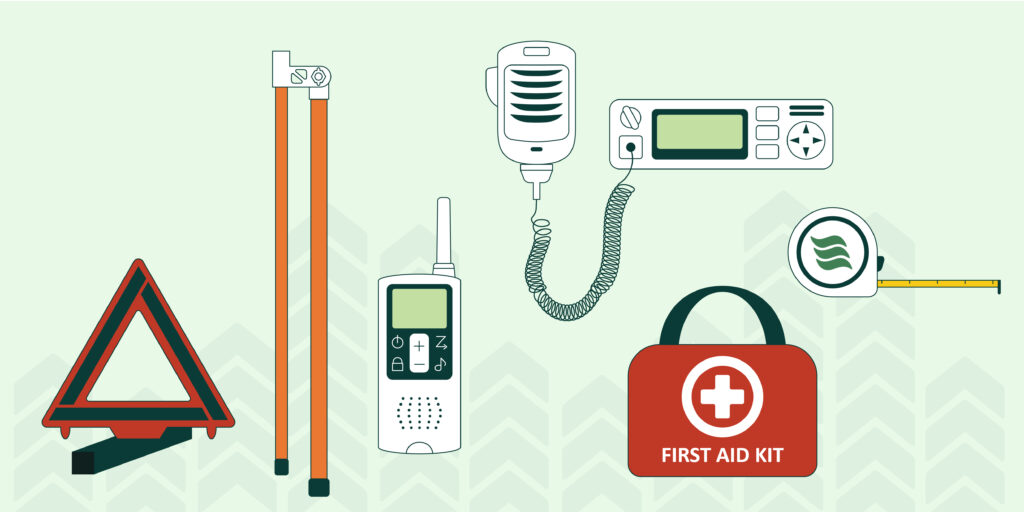New Pilot/Escort Vehicle Operators (PEVOs) are usually responsible for acquiring their own equipment. Below are our recommendations for what to have, based on our Washington State Pilot/Escort Vehicle Operator Certification curriculum and the recommendations of the National Pilot Car Association.
Please keep in mind that your state or jurisdiction may have additional requirements.
Evergreen Safety Council does not maintain a list of pilot car equipment suppliers. Several online retailers can be found by searching for “pilot car equipment” online.
Outfitting your vehicle
- An Oversize Load sign mounted to the roof of the vehicle, and visible from both the front and back. It should be retractable or removable.
- At least one roof-mounted flashing or rotating amber (yellow) strobe light. Lights must be visible 360 degrees for a minimum of 500 feet. In Washington State, light bars, with appropriately colored lights that meet the visibility minimums, are also acceptable.
- A professional-grade, nonconductive, adjustable high pole with extra tips.
- At least one high pole mount on the front of the vehicle, preferably welded to the frame.
- A quality 40-channel, 4-watt radio installed in your vehicle. Voice activated or other “hands-free” equipment is recommended.
- At least one handheld two-way radio, with extra batteries.
PPE (Personal Protective Equipment)
- A high-visibility upper garment, such as a vest or jacket, with retroreflective banding. The garment should be fluorescent yellow-green, fluorescent orange-red, or fluorescent red. Make sure the tag says that the garment is ANSI Class 2 or 3 compliant.
- A hi-vis hard hat. Acceptable colors include white, yellow, yellow-green, orange, or red. It should be marked with retroreflective banding for added visibility at night.
- A pair of hi-vis (ANSI Class E) pants for use at night.
- Hi-vis gloves are recommended for situations where you will be flagging.
Signaling equipment
- At least 3 bi-directional emergency reflective triangles, plus 3 or more 28-inch orange traffic cones with retroreflective collars
- A flashlight with a red nose cone, additional batteries, and extra bulb
- An 18-inch retroreflective STOP/SLOW paddle. It is recommended that you also have a 6-7 foot staff that the paddle can be mounted on. A 24-inch paddle is recommended for use at night.
- A weighted, 24-inch red flag mounted on a 36-inch staff
Other equipment
- A first aid kit that complies with OSHA standard 1910.266 App A
- A combination type B, C extinguisher with a metal head, mounted to the vehicle
- A rigid height measuring device and an extra-long tape measure for measuring loads and high pole settings
- Recommended repair supplies:
- Tool box with basic tools
- Electrical or duct tape
- Rope
- Work gloves, tarp
- Jumper cables
- Flat tire inflator, spare tire
- Antifreeze, motor oil, windshield washer fluid, automotive fuses, fan belt
- Extra headlight and taillight bulbs
- Recommended emergency supplies and equipment:
- Whistle
- Lighted warning devices or flares
- Tire chains
- Emergency supply of food and drinking water
- Emergency blanket, cold weather clothing, and rain gear
- Safety glasses and/or non-reflective sunglasses
- Sunscreen
- Accident report kit
Having the right equipment is only part of the puzzle. Inspect your equipment regularly and make sure you’re prepared for any emergencies that may arise. It’s important to make sure you have the right certifications and insurance for the state(s) where you are operating, as well.
If you haven’t gotten certified yet, be sure to check out our Washington State PEVO course, where you’ll learn all this and more.
